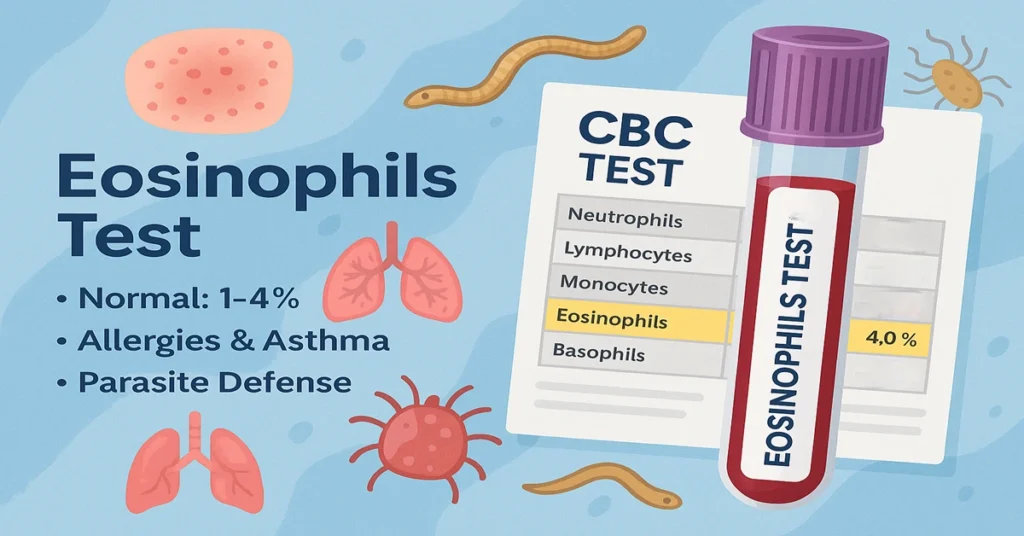What are Eosinophils?
Eosinophils are a type of white blood cell (WBC), belonging to the granulocyte family. They play an important role in the immune system by fighting parasites, controlling allergic reactions, and regulating inflammation. Under a microscope, eosinophils are recognized by their reddish-pink granules when stained with eosin dye.
Where are Eosinophils Produced in the Body?
Eosinophils are produced in the bone marrow from stem cells. After maturing, they circulate in the blood for a short time before moving into tissues like the skin, lungs, and intestines, where they carry out their functions.
Main Functions and Importance
- Defend Against Parasites: Destroy worms and protozoa.
- Allergy Response: Involved in asthma, hay fever, and eczema.
- Control Inflammation: Regulate immune reactions to prevent excess damage.
- Release Enzymes & Toxins: Their granules release substances that kill invaders.
- Work with Other Immune Cells: Interact with mast cells, basophils, and antibodies.
Causes of Low Eosinophil Levels (Eosinopenia)
- Corticosteroid use (like prednisone)
- Acute stress or trauma
- Cushing’s syndrome
- Severe infections causing immune suppression
- Sepsis (severe bacterial infection)
Symptoms of Low Eosinophils
Low eosinophils usually do not cause direct symptoms but may indicate:
- Weakened immune response
- Ongoing stress or effects of steroid medication
Causes of High Eosinophil Levels (Eosinophilia)
- Parasitic infections (worms, protozoa)
- Allergic conditions: asthma, eczema, hay fever
- Autoimmune diseases: lupus, rheumatoid arthritis
- Certain cancers: leukemia, lymphoma
- Drug-induced allergic reactions
- Chronic infections
- Rare: Hypereosinophilic syndrome (overproduction of eosinophils)
Symptoms of High Eosinophils
Symptoms depend on the underlying cause and may include:
- Wheezing, coughing, or shortness of breath (asthma)
- Itchy skin or rashes (eczema, allergies)
- Abdominal pain and diarrhea (parasites)
- Fever and fatigue
- Enlarged lymph nodes or spleen (in severe eosinophilia)
Reference Range
(may vary slightly by lab)
- Absolute Eosinophil Count (AEC): 0 – 500 cells/µL
- Percentage of Total WBCs: 1% – 4%
Sample Type
- Sample: Whole blood
- Tube Used: Lavender-top EDTA tube
Test Preparation
- Usually no fasting required.
- Inform your doctor about medications (especially steroids or allergy drugs).
- If you have allergies or parasitic infections, mention symptoms to your doctor.
When to Consult a Doctor
- If you have frequent allergies, asthma, or unexplained rashes.
- If you experience stomach issues with diarrhea or suspected parasitic infection.
- If your CBC report shows very high or very low eosinophil count.
- If you feel fatigued with swollen glands or enlarged spleen.
Key Terms Explained
- Eosinophils: WBCs with pink granules, fight parasites & allergies.
- Eosinophilia: High eosinophil count.
- Eosinopenia: Low eosinophil count.
- Granulocytes: A group of WBCs (including eosinophils, neutrophils, basophils) with granules.
- CBC with Differential: A blood test showing breakdown of all WBC types.
~END~

